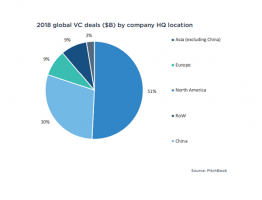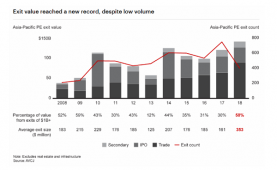China
Asia's cruise passenger market up 4.6% to 4.24 million in 2018
China remains the top source market, accounting for 55.8% of Asian passengers. Asia’s cruise passenger source market hit a new high in 2018, with 4.24 million people going on an ocean cruise, up 4.6% YoY, according to data released by Cruise Lines International Association (CLIA). Most of the source markets in Asia saw year-on-year gains in 2018, including Singapore (39.9% to 373,000), India (28.1% to 221,000), Indonesia (54.9% to 72,000), Philippines (49.1% to 61,000), South Korea (13.5% to 44,000), Thailand (14.5% to 30,000) and Vietnam (53.7% to 10,000). Meanwhile, data showed that mainland China retained its dominance as a source market, accounting for 55.8% of all Asian passengers, though the Chinese market has been going through a period of adjustment and saw a marginal 1.6% decline in passengers. The more measured increase in Asia’s passenger volume did not come as a surprise, as cruise ship capacity dipped in 2018 after years of rapid expansion in this region, according to the report. Asia’s slowdown in ship capacity is due to the strong demand for cruise ships worldwide, and reduced short cruise itinerary options ex-mainland China. “In the next few years, cruising in Asia is expected to continue growing in popularity with the arrival of new ships in 2019/2020 including from Costa Cruises, Genting Cruise Lines, Royal Caribbean International and MSC Cruises,” CLIA managing director for Australasia & Asia Joel Katz explained. Asia continues to be the cruise industry’s third largest market after North America and Europe, the CLIA figures show, maintaining a 14.8% share of the total global ocean passenger volume (28.5 million) for 2018.
Asia's cruise passenger market up 4.6% to 4.24 million in 2018
China remains the top source market, accounting for 55.8% of Asian passengers. Asia’s cruise passenger source market hit a new high in 2018, with 4.24 million people going on an ocean cruise, up 4.6% YoY, according to data released by Cruise Lines International Association (CLIA). Most of the source markets in Asia saw year-on-year gains in 2018, including Singapore (39.9% to 373,000), India (28.1% to 221,000), Indonesia (54.9% to 72,000), Philippines (49.1% to 61,000), South Korea (13.5% to 44,000), Thailand (14.5% to 30,000) and Vietnam (53.7% to 10,000). Meanwhile, data showed that mainland China retained its dominance as a source market, accounting for 55.8% of all Asian passengers, though the Chinese market has been going through a period of adjustment and saw a marginal 1.6% decline in passengers. The more measured increase in Asia’s passenger volume did not come as a surprise, as cruise ship capacity dipped in 2018 after years of rapid expansion in this region, according to the report. Asia’s slowdown in ship capacity is due to the strong demand for cruise ships worldwide, and reduced short cruise itinerary options ex-mainland China. “In the next few years, cruising in Asia is expected to continue growing in popularity with the arrival of new ships in 2019/2020 including from Costa Cruises, Genting Cruise Lines, Royal Caribbean International and MSC Cruises,” CLIA managing director for Australasia & Asia Joel Katz explained. Asia continues to be the cruise industry’s third largest market after North America and Europe, the CLIA figures show, maintaining a 14.8% share of the total global ocean passenger volume (28.5 million) for 2018.
China slowdown to weaken APAC cross-border sentiment in 2019
Chinese corporates' onshore funding costs are forecasted to fall further.
Chinese banks suffer heavy losses as delinquencies hit $17.88b in January
The energy sector saw the most defaults of $6.94b.
China's VC deal value surged 89% to $78.2b in 2018
Chinese startups clinched almost 1 in 3 global VCs.
APAC private equity exits hit $142b in 2018
The surge in exit values outpaced the previous all-time high of $125b recorded in 2014.
China to develop platform economy in 2020
The country is aiming to build a commodity circulation system that fits the modern economic system.
China needs US$596.51b of stimulus to reach GDP target
Investments in infrastructure and construction are expected to boost growth.
Chinese TMT IPO proceeds triples to $264.9b in 2018
China Tower Corp, Xiaomi Corp and Meituan Dianping had the largest IPOs in H2 2018.
Asia's fintech investments hit $22.7b in 2018
It was led by online payment provider Ant Financial’s mammoth $14b series C funding round.
China's bloated PPP pipeline hit $1.95t in 2018
The total investment is almost double that recorded in end-2016.
China's PE activity hits record highs at $222b in 2018
It offset the 23% decline in China’s outbound M&A activity which dropped for the third consecutive year.
China's exports rebounded 9.1% in January
Exports to EU, Japan, South Korea and ASEAN have recovered.
China heightens infrastructure spending to prop up slowing economy
The government is actively spending for railway, highways, airports and water conservancy projects.
Solar and wind to snap up 16% of China's power mix by 2028
Cost deflation for wind and solar could sustain the momentum of renewables.
Chinese tech cities accounted for 36% of global VC investments in 2018: report
This translates to $74.8b of the $207.8b investment volumes.
China's outbound M&A likely to slide further in 2019
Regulatory scrutiny from US and Europe and tight funding conditions are to blame.
APAC's asset and wealth managers to hit US$29.6t in AUM by 2025
Shanghai is set to rise as an AWM hub along with Singapore and Hong Kong.



















 Advertise
Advertise





















Commentary
AI is revolutionising learning: Why should educational institutions in Singapore embrace this change?
Seeking an office space in Singapore: Where do you start?